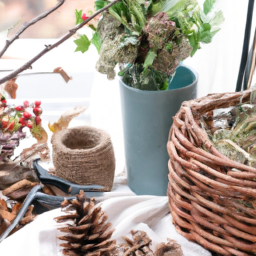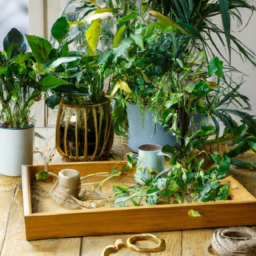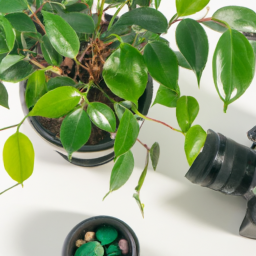
As the temperatures start to drop and frost begins to settle in, it’s time to start thinking about bringing plants in for the winter. Whether you have a lush garden or a few potted plants on your porch, it’s important to take the necessary steps to ensure your green friends survive the cold months ahead. In this blog post, we’ll discuss the best practices for transitioning your plants indoors, so they can thrive throughout the winter season. Let’s dive in and learn how to keep your plants happy and healthy during the chilly months.
Benefits of Bringing Plants Indoors for the Winter
Improved Plant Health
During the winter months, outdoor plants are exposed to harsh conditions such as freezing temperatures, strong winds, and snow. Bringing your plants indoors can help protect them from these elements and ensure they stay healthy throughout the winter. Indoor environments are typically more stable in terms of temperature and humidity, which can promote better growth and overall plant health.
Additionally, indoor plants are less prone to pests and diseases that thrive in outdoor environments during the winter. By bringing your plants indoors, you can prevent common winter pests such as spider mites and aphids from infesting your plants and causing damage. This can help your plants thrive and continue to grow during the colder months.
Furthermore, indoor plants are not exposed to the drying effects of winter winds and can retain more moisture in their leaves and stems. This can prevent issues such as leaf desiccation and wilting, which can occur when plants are exposed to cold, dry air. By bringing your plants indoors, you can ensure they stay hydrated and healthy throughout the winter.
In conclusion, bringing your plants indoors for the winter can have numerous benefits for their overall health and well-being. By providing them with a stable environment, protection from pests and diseases, and adequate moisture, you can help your plants thrive during the colder months.
Extended Growing Season
Bringing your plants indoors for the winter can also help extend their growing season and allow you to enjoy fresh produce and flowers year-round. Many plants that are typically grown outdoors during the warmer months can be successfully grown indoors with the right care and conditions.
For example, herbs such as basil, mint, and parsley can be grown indoors throughout the winter and used in cooking to add fresh flavor to your meals. Additionally, flowering plants such as orchids and African violets can bloom indoors during the winter, adding beauty and color to your home during the colder months.
By bringing your plants indoors, you can continue to enjoy gardening and growing plants even when the weather outside is not conducive to outdoor gardening. This can be especially beneficial for those who have a green thumb and enjoy tending to plants year-round.
Overall, bringing your plants indoors for the winter can help extend their growing season and allow you to continue enjoying fresh produce and flowers throughout the colder months. With the right care and attention, you can create a thriving indoor garden that brings beauty and joy to your home.
Tips for Bringing Plants Indoors
When bringing your plants indoors for the winter, it is important to take certain steps to ensure they transition smoothly and thrive in their new environment. Here are some tips to help you successfully bring your plants indoors for the winter:
1. Inspect your plants for pests and diseases before bringing them indoors. Remove any affected leaves or stems and treat the plants with insecticidal soap or neem oil if necessary.
2. Gradually acclimate your plants to indoor conditions by placing them in a shaded area for a few days before bringing them inside. This will help prevent shock and allow the plants to adjust to lower light levels.
3. Choose a bright location for your plants indoors, such as a south-facing window or under grow lights. Provide adequate humidity by placing a tray of water near your plants or using a humidifier.
4. Water your plants as needed, taking care not to overwater or underwater. Monitor the moisture levels in the soil and adjust your watering schedule accordingly.
5. Fertilize your plants regularly with a balanced fertilizer to provide them with essential nutrients for growth. Follow the instructions on the fertilizer package for best results.
By following these tips, you can successfully bring your plants indoors for the winter and help them thrive in their new environment. With proper care and attention, your plants can continue to grow and flourish throughout the colder months, bringing beauty and greenery to your home.

Tips for Successfully Transitioning Plants Inside for Winter
Preparing Your Plants for the Move
As the weather starts to cool down and winter approaches, it’s time to start thinking about bringing your outdoor plants inside. This transition can be a bit tricky, but with the right preparation, you can ensure that your plants thrive throughout the winter months.
First, it’s important to assess which plants will need to come inside. Tropical plants, succulents, and any plants that are not cold-hardy should be moved indoors before the first frost. Take inventory of your plants and make a list of what needs to be brought inside.
Next, you’ll want to start preparing your plants for the move. Begin by inspecting each plant for pests and diseases. If you notice any issues, treat them before bringing the plant inside to prevent infestations from spreading to your other plants.
Once your plants are pest-free, it’s time to start acclimating them to their new indoor environment. Begin by gradually reducing the amount of sunlight your plants receive each day. This will help prevent shock when you move them inside where light levels are lower.
Choosing the Right Location Inside
When bringing your plants inside for the winter, it’s important to choose the right location for them to ensure they thrive. Ideally, you’ll want to place your plants in a spot that receives plenty of natural light, such as a south-facing window. If natural light is limited, you may need to supplement with grow lights to ensure your plants get the light they need.
Temperature is another important factor to consider when choosing a location for your plants. Most indoor plants prefer temperatures between 65-75 degrees Fahrenheit during the day and slightly cooler temperatures at night. Avoid placing your plants near drafty windows or heating vents, as extreme temperature fluctuations can stress your plants.
Humidity is also important for many indoor plants, especially tropical varieties. To increase humidity around your plants, you can place a tray of water near them or use a humidifier. Misting your plants with water can also help increase humidity levels.
Caring for Your Plants Indoors
Once your plants are settled into their new indoor home, it’s important to continue to care for them properly to ensure they thrive throughout the winter. Watering is one of the most important aspects of indoor plant care, as the dry indoor air can cause plants to dry out more quickly. Check the soil regularly and water your plants when the top inch feels dry to the touch.
Fertilizing is another important aspect of caring for your indoor plants. While plants may not need as much fertilizer during the winter months when they are not actively growing, it’s still important to provide them with some nutrients. Use a balanced fertilizer diluted to half strength every 4-6 weeks to keep your plants healthy.
Finally, keep an eye out for pests and diseases that can thrive in the indoor environment. Inspect your plants regularly for any signs of pests, such as yellowing leaves or sticky residue. If you notice any issues, treat them promptly to prevent them from spreading to your other plants.
By following these tips for successfully transitioning your plants inside for winter, you can ensure that your plants stay healthy and thriving throughout the colder months. With proper care and attention, your indoor plants will be ready to move back outside when the weather warms up again in the spring.

Best Practices for Caring for Indoor Plants During the Winter Months
As the winter months approach, it’s important to start thinking about how to care for your indoor plants. The colder temperatures and lower humidity levels can have a negative impact on your plants, so it’s essential to take some extra steps to ensure they thrive during the winter. Here are some best practices for caring for indoor plants during the winter months.
1. Adjusting Watering Schedule
One of the most important things to consider when caring for indoor plants during the winter is adjusting your watering schedule. During the colder months, plants tend to require less water as they are not actively growing. Overwatering can lead to root rot, so it’s crucial to monitor the soil moisture levels and only water when necessary.
Before watering your plants, always check the soil to see if it’s dry. Stick your finger into the soil up to your knuckle – if it feels dry, it’s time to water. It’s also a good idea to use room temperature water, as cold water can shock the roots of your plants.
Additionally, consider using a moisture meter to accurately determine when your plants need water. This tool can help prevent overwatering and ensure your plants are getting the right amount of moisture during the winter months.
2. Providing Adequate Light
During the winter months, the days are shorter and natural light is limited. This can be challenging for indoor plants, as they rely on light for photosynthesis. To ensure your plants are getting enough light, consider moving them closer to windows or investing in grow lights.
If you’re unable to provide enough natural light for your plants, consider rotating them regularly to ensure all sides receive adequate light. Keep in mind that different plants have different light requirements, so it’s essential to research the specific needs of each plant in your collection.
Remember to clean your windows regularly to allow maximum light to penetrate through. Dust and grime can block sunlight, which can hinder the growth of your indoor plants during the winter months.
3. Maintaining Humidity Levels
Indoor plants thrive in humid environments, but the winter months can bring dry air that can be detrimental to your plants. To maintain optimal humidity levels, consider using a humidifier in your home or placing a tray of water near your plants to increase moisture in the air.
You can also mist your plants regularly to increase humidity levels around them. However, be cautious not to overdo it, as excessive misting can lead to fungal diseases. Monitor the humidity levels in your home using a hygrometer to ensure your plants are in the right environment.
If you have a collection of tropical plants, consider creating a mini greenhouse by covering them with a plastic bag or placing them in a terrarium. This can help trap moisture and create a humid microclimate for your plants to thrive in during the winter months.
Highlights of this article
As the weather starts to cool down and frost becomes a possibility, it’s time to start thinking about bringing your outdoor plants inside for the winter. Many plants that thrive in the warmer months won’t survive the cold temperatures, so it’s important to give them a cozy indoor environment to keep them healthy until spring rolls around again.
Before bringing your plants inside, make sure to inspect them for any pests or diseases that could spread to your other houseplants. Give them a good watering and prune any dead or damaged leaves to help them acclimate to their new indoor environment. Find a sunny spot in your home where they can get enough light, and consider investing in a humidifier to mimic their outdoor environment. With a little care and attention, your plants can thrive indoors during the winter months and be ready to go back outside once the weather warms up again.
Top FAQs:
Q1: Why should I bring my plants indoors for the winter?
A1: Bringing plants indoors for the winter is important to protect them from the harsh cold temperatures that can damage or kill them. Indoor environments provide a controlled climate that is more suitable for many plants during the colder months.
Q2: Which plants should I bring indoors for the winter?
A2: It is recommended to bring in tropical plants, succulents, and any plants that are not cold-hardy. These plants are more sensitive to cold temperatures and will not survive outside during the winter.
Q3: How should I prepare my plants for the transition indoors?
A3: Before bringing your plants indoors, make sure to inspect them for pests and diseases. Trim any dead or damaged leaves, and repot them if needed. Gradually acclimate them to indoor conditions by placing them in a shady spot for a few days before bringing them inside.
Q4: How should I care for my plants once they are indoors for the winter?
A4: Make sure to place your plants in a location with adequate sunlight, water them according to their specific needs, and monitor them for any signs of pests or diseases. You may also want to increase humidity levels by using a humidifier or placing a tray of water near your plants.
Q5: When should I consider bringing my plants back outside in the spring?
A5: Once the threat of frost has passed in the spring, you can start acclimating your plants to outdoor conditions again. Gradually reintroduce them to sunlight and outdoor temperatures to prevent shock. Make sure to monitor them closely for any signs of stress during this transition period.
Dr. Olivia Green is a botanist with over two decades of experience in indoor plant cultivation. She holds a Ph.D. in Plant Biology and has dedicated her career to researching plant behavior in controlled environments. Dr. Green is passionate about helping plant enthusiasts master the art of indoor gardening through her extensive knowledge and practical insights.


